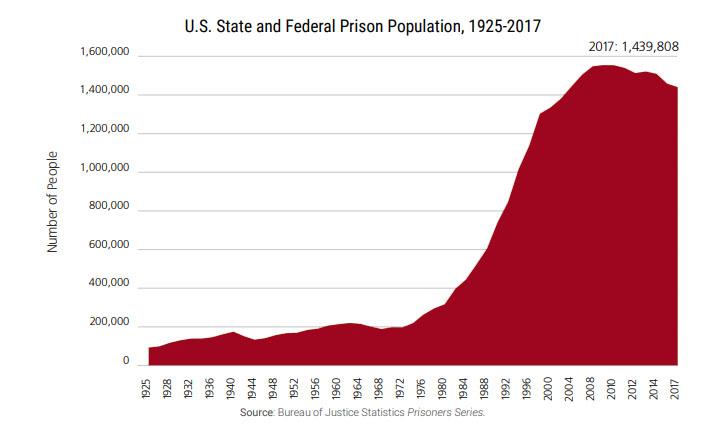A Factory of Human Suffering The Horrific Truth Behind Mass Incarceration By Ballard Morton Nearly every aspect of American society has been influenced—if not entirely revolutionized—by our passage into modernity. Among other things, our technology has grown smarter, our consumer goods have become cheaper, and our healthcare and medicine have been engineered to save more lives and to ensure greater quality of life. It is almost impossible to name a feature of our American civilization that has gone entirely untouched by our several decades of scientific, technological, economic, social, and political progress. Our criminal justice and prison systems, however, are exceptions of cosmic proportions. In an era otherwise defined by modernity, American justice is a relic of our primitive past. The majority of those reading will very likely never have to face the direct consequences of mass incarceration. Thus, criminal justice and prison reform may seem altogether unimportant, or at the very least, a distraction from more pressing political issues such as healthcare and climate change. Nevertheless, mass incarceration is one of the most pressing issues of our time, and it merits political solutions and deliberation accordingly. To this end, I believe that the American criminal justice and prison systems are exceedingly harmful and counterproductive institutions. They are systems for which we pay great costs and reap no benefits in return. In this article, I will be addressing three main issues that, in my view, contribute most to mass incarceration: 1) Overcriminalization & Sentencing 2) Prosecutorial Tactics & Incentives 3) The Conditions & Punitive Nature of Jails & Prisons Overcriminalization & Sentencing Currently in the United States, roughly 1 in 3 American adults has a criminal record, and approximately 2.1 million Americans are incarcerated in local, state, and federal jails and prisons. 2.1 million. That’s about 1 in every 100 American adults, or the population of Houston, Texas, America’s 4th most populous city. This rate of incarceration is higher than that of any country in the world. Although one may reasonably suspect that this is a justifiable cost to pay for public safety, mass incarceration is in fact detrimental to public safety and does very little
30
to actively promote the security of American citizens. One of the reasons for America’s outrageously high rate of incarceration is the problem of overcriminalization as well as the lengths of inmates’ sentences. This is particularly true of drug offenses. Approximately 350,000 people are incarcerated in a local, state, or federal jail or prison for a drug offense. Between 1980 and 2017, the number of Americans incarcerated in local jails for drug offenses jumped from approximately 20,000 to 185,000. In federal prisons, it jumped from 5,000 to 92,000. In 2009, the U.S. Sentencing Commission found that high-level traffickers and importers accounted for only 11% of those federally incarcerated for a drug offense. Furthermore, the problem is not only the number of people incarcerated for drug offenses, but also the time they are spending behind bars. The average time drug offenders in the U.S. spend behind bars in state prisons jumped from 1.6 years to 2.2 years between 1980 and 2009. For federal drug offenses, the average time jumped from approximately 2 to 5 years on average between 1988 and 2012. Mandatory minimums (minimum sentences required for certain, generally benign offenses) and “threestrikes” laws are no doubt blameworthy for these trends in drug sentencing. With regard to crime more generally, a University of Nottingham study found that, although the U.S. comprises only 4% of the global prison population, the U.S. is responsible for approximately one-third of the world’s total life sentences. In considering these data, a skeptic may intuitively believe the following: 1) repeated drug use is bad for people, and strict drug laws are required to deter people from abusing substances; 2) strict drug laws reduce rates of violent crime and thus promote public safety. As to the first point, no correlation between the harmful effects of drug use and drug laws has been proven to exist. In fact, to the contrary, a 2018 study by the Pew Research Center shares the following: “Pew compared state drug imprisonment rates with three important measures of drug problems— self-reported drug use (excluding marijuana), drug arrest, and overdose












